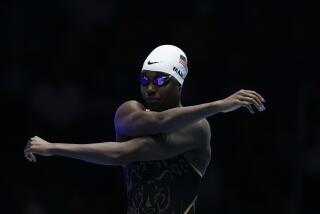Testing the Waters in Open-Ocean Competitions
- Share via
Attention lap swimmers: Everybody out of the pool, and into the ocean.
Two Orange County swims Sunday will offer just about the last chance of the season to sample the sport of open-ocean swimming. The 3/4-mile Newport Pier Swim, part of the Newport SeaFest celebration, coincides with the one-mile Great Beach Challenge at Bolsa Chica State Beach.
It’s a bit shorter than the annual Pier-to-Pier Swim between the Balboa and Newport piers in July (two miles) and a grueling annual distance championship in Seal Beach (10 miles). According to organizers, the Newport Pier Swim typically takes about 15 minutes for the winners, 25 minutes or so for the slower competitors.
Because of the moderate length, the event is a good place for lap swimmers interesting in trying the open ocean to “test the waters,” says Jim Turner, who has organized the contest for the Newport lifeguards for the past four years. “We get everything from very competitive swimmers to just recreational swimmers,” Turner says.
Lap swimmers who are getting out of the pool for the first time should expect to make some adjustments.
“The water’s quite a bit colder (than a pool) and it can be choppy when they swim,” says Turner. The entry and exit through the surf, he adds, can be “tiring or difficult.”
Bill Leach of Newport Beach, a former Olympic kayaker who now competes in triathlons, advises competitors in an open-ocean swim to check out the entry area before the race. Knowing what the sand is like below the water (how quickly it drops off, how even the bottom is) is not only a smart race tactic, but it can also add to safety.
“You’ll want to test the terrain a little bit, so you don’t end up running into a hole or diving into a sandbar,” Leach said.
Fighting the surf is another entry problem. When a wave approaches, Leach ducks and “grabs” the bottom with his hands, then pushes off with his legs after the wave has passed. “The worst thing is just to stand there and let the wave hit you,” Leach says.
The surf can actually be a boon at the end of a race, when competitors are heading back to land, if you know how to body surf. “It depends on the conditions,” Leach says. “You can actually pass dozens of people, if you catch a wave and they don’t.”
Beyond the surf line, other difficulties surface. In pools, swimmers are provided with convenient lines to assist in following a straight path. And they don’t have ocean currents to contend with. “The problem you have in open-ocean swimming is keeping a straight line,” Leach says.
Sometimes, buoys are used to mark the course; at other times, swimmers have to use other landmarks to mark their progress. In either case, swimmers must learn to “breathe with your head up” so as to “get a breath and at the same time sight where you’re going,” Leach says. Most swimmers check their position every third or fourth stroke.
“You’ve got to learn to breathe on both sides,” says Leach’s wife, Julie, the women’s winner of the 1982 Ironman Triathlon. She points out that lap swimmers who learn to turn their head to one side to breathe may have to turn it the other way to check buoys or other markers in the open ocean, which some swimmers find difficult.
“To me, open ocean swimming is totally different from lap swimming,” says Julie Leach. “I got totally nauseated the first time I did it” because of the swells.
She has had to contend with other problems over the years: Once, in the mass run into the water, “I got kicked so hard in the goggles, I had a black eye by the end of the race.” Another time, a strong current on a pier swim threatened to carry her into the pilings. “It was scary,” she says. “I was swimming as hard as I could just to stay away from the pilings.”
Clearly, open-ocean swimmers face difficulties that lap swimmers never meet, but those challenges are also part of the draw. Turner estimates that between 60 and 80 people will compete in Sunday’s swim.
Mike Fillipow of Seal Beach has been hitting the rough-water swims heavily this summer. A triathlete who competed professionally for three years, he sustained an injury last spring that has kept him from running or bicycling.
He feels his emphasis on swimming over the past few months have enhanced his skills there tremendously, and he believes that more triathletes should take advantage of the summer swims.
“They’re a great opportunity for the triathletes to get some good training,” Fillipow says. Also, “It gets you out of the pool. The pool can be so boring, following that little line.”
Fillipow suggests that first-time competitors stay away from the front of the pack at the start of the race, where they can get trampled in the rush to the surf line. Another tip he offers is a bit of strategy: following closely in the wake of another swimmer will cut down on water resistance and make for a faster, easier swim, a technique known as “getting on somebody’s feet.”
As for training, Bill Leach says that most ocean swimmers and triathletes do most of their practice work in the pool, where they can get a consistent workout. Leach, a former lifeguard, rarely hits the open water except in competition, but swimmers who are less familiar with the vagaries of paddling the ocean often train in the open water once a week or so.
Fillipow advises that swimmers never venture out alone in the ocean, and suggests that they take advantage of summer group swims that are offered by many swim clubs.
Some swim races and most triathlons allow the use of wet suits (special swimming wet suits, cut for full arm movement, cost from $150 to $250). Races held under the aegis of the U.S. Masters Assn., such as both of Sunday’s swims, do not allow wet suits.
For insurance reasons, participants in Sunday’s pier swims must join the masters group ($20 enrollment fee).
The entry fee for the Newport Pier Swim is $15. The race begins at the 28th Street jetty at 10 a.m., with registration beginning at 9:15 a.m. For information, call (714) 644-3044.
The Great Beach Challenge offers a series of swim-related events, with an entry fee of $25 for all events. The one-mile swim begins at 10 a.m. at lifeguard headquarters. For information, call (714) 846-3460.
SeaFest includes a number of other recreational events. For details, call (714) 729-4400.
A kite festival, with contests and demonstrations by professional kite flyers, will be held Saturday and Sunday, 10 a.m. to 4 p.m., at Balboa Park, Main Street and Balboa Boulevard.
The SeaFest Huff & Puff includes a 30-K bike ride, along with 5- and 10-K runs and a 5-K walk. The events will be held Sunday from 7:30 to 11 a.m. at Newport Dunes Aquatic Park, 1131 Backbay Drive.
A health and sports exposition will be held during the Huff & Puff events.


